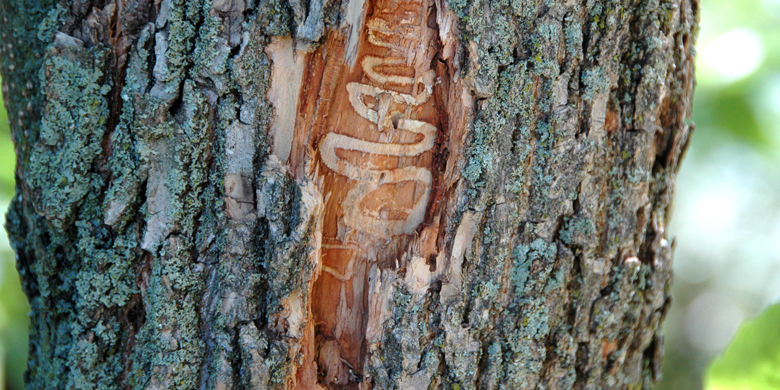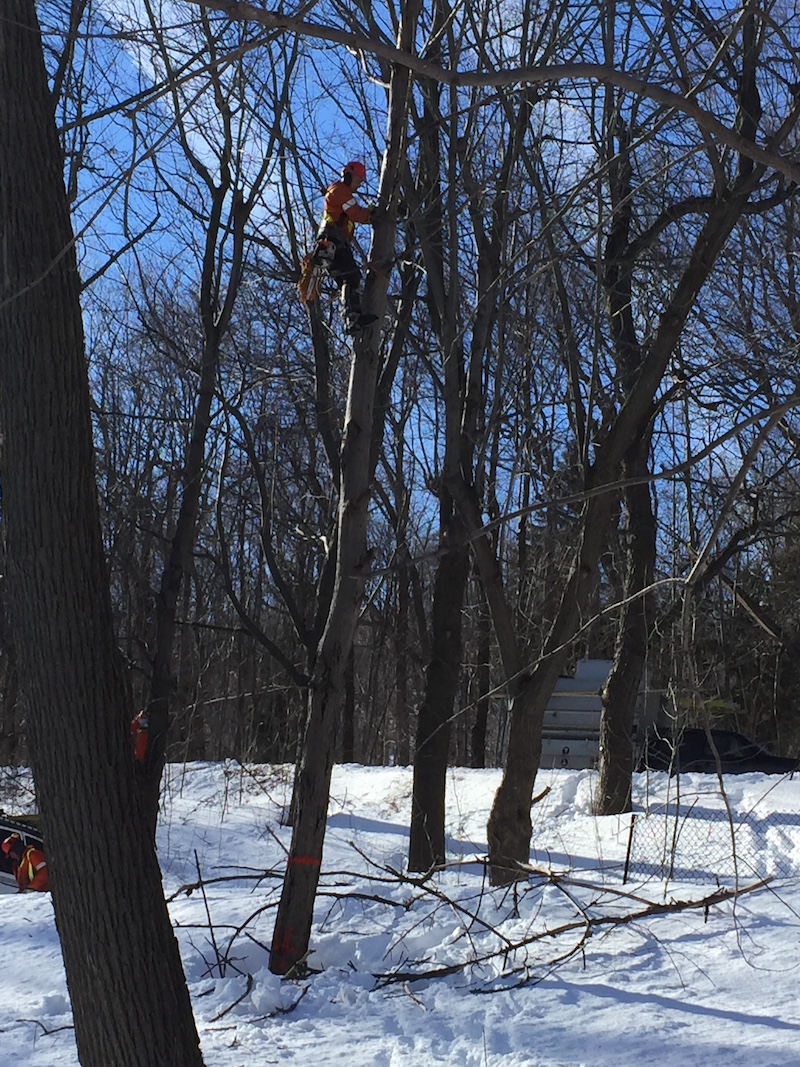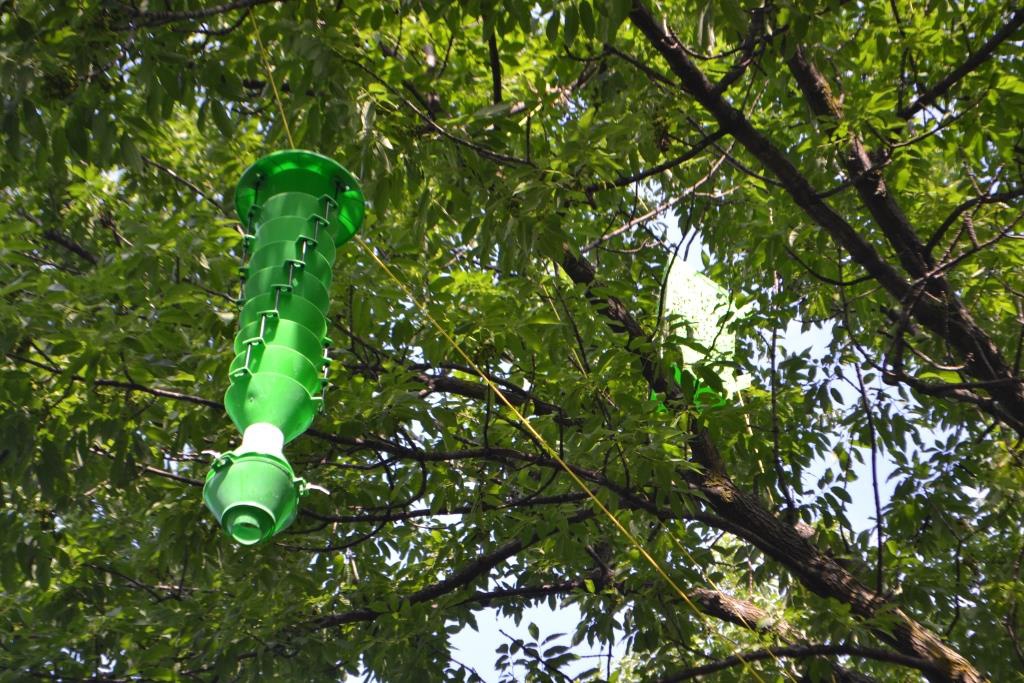Everything You Always Wanted to Know About the Emerald Ash Borer on Mount Royal
- March 04, 2019
If you have recently visited the mountain, perhaps to stroll on Olmsted Path or to enjoy the view from the Camillien-Houde lookout, you might have seen or heard felling operations in the woods. The reason behind all this noise is a little insect that is causing a lot of damage to our green spaces: the emerald ash borer. Now, after more than two years, the mountain will once again become a haven of peace and tranquility.

Moving Mountains to Tackle the Infestation
It was in 2011 that the first case of emerald ash borer (EAB) was discovered in Montréal. The following year, the City of Montréal put in place a strategy to reduce the impact of this insect on Montréal's urban forest. The intervention in woodlands started a little later, in 2017, when the first actions were undertaken on the mountain. Indeed, this bright green insect pest from Asia poses a major threat to the entire territory.
The City completed a comprehensive inventory of the mountain’s 10,000 ash trees and the results were decisive: 6,000 ash trees were healthy, but 4,000 were dead or dying due to the EAB in the woodlands of Mount Royal Park and Tiohtià: ke Otsira'Kéhne Park on Outremont Summit.
The City thus put into action its four-step campaign:
Treating 6,000 Ash Trees: Prevention Is Better Than Cure
As of today, there is no treatment to successfully eradicate the EAB. That being said, it is possible to slow the infestation and limit the death of trees by treating healthy ash trees every two years. To this end, the City has quickly treated the 6,000 healthy ash trees on Mount Royal by injecting the TreeAzin® bioinsecticide into tree trunks. This is the treatment used by the City of Montréal.
Felling 4,000 Ash Trees: Desperate Times Call for Desperate Measures
It is important to keep in mind that measures against the emerald ash borer ultimately help maintain the integrity of Mount Royal's woodlands. To lessen the overall impact of felling operations, dead or dying trees were chopped down in phases:
January and February 2019 saw the final felling operations on Mount Royal: 900 ash trees in the Piedmont sector, around the Camillien-Houde lookout, and 440 ash trees in the park along Cedar and Pine avenues. This completed the cut of 4,000 ash trees planned two years ago.
The last phase of the City’s campaign will include reforestation activities in various sectors of the mountain from 2018 to 2020.
 Ecological Rehabilitation
Ecological Rehabilitation
To compensate for the loss of ash trees and preserve the exceptional quality of Mount Royal's natural environment, the City will plant thousands of trees and shrubs by 2020. In 2018, a total of 7,120 trees and 2,130 shrubs were planted.
Reforestation is a vital operation that will close gaps caused by felling, prevent colonization by invasive plant species and increase the diversity of trees in the forest.
Les amis de la montagne contributes to reforestation efforts by conducting a number of planting actions as part of our Environmental Stewardship Program, which also prioritizes the control of invasive species in intervention zones.
Wood Can Be Recovered and Reused
For some, the EAB infestation has been an opportunity to develop urban projects using reclaimed ash wood. However, infested wood must be treated by specialists to be recovered properly without any traces of borer. Felled trees may contain borer larvae under the bark, which are not always visible.
Depending on their diameter, ash trees recovered from Mount Royal are transformed into wood chips (this destroys any last trace of larva under the bark) or lumber that can be used for various local urban projects.
In the spring of 2018, the City awarded a contract to the group Bois public to transform the wood from felled ash trees in Mount Royal and Tiohtià: ke Otsira'kéhne Parks. Some 150 ash logs will be dried and planed for cabinetmaking projects. In addition to converting logs into planks, the project will serve to build a solar kiln to dry wood, develop community partnerships for reclaimed wood projects, and design and make approximately 75 furniture items.
Another of one such projects was the Café suspendu, which was located at the Camillien-Houde Beldevere in the summer of 2018 and made from reclaimed ash wood.

crédit photo: La Pépinière | Espace collectif
Testing Alternative Ecological Solutions
Various research projects in North America use biological control mechanisms by pests or fungi that affect the borer. Here, in Mount Royal Park in the summer of 2017, funnel traps were installed in ash trees in the open grassy areas. Using female pheromones, these funnel devices were used to attract and infect male borers with a natural fungus who then infested females during mating. If effective, this treatment should be done annually.

Asian Wasps Join in the Fight
Another project, which was carried out in Westmount’s Summit Woods, consisted in releasing two species of parasitic wasps (natural enemies of the borer) in wooded areas. These wasps contaminated borers by laying their eggs in borer eggs or larvae. Both these parasitoid species hail from the same region in China as the EAB and pose no threat to humans. This project has been tested in other parks in Montréal, but it will take several years before significant results are obtained and wasp populations are established on the mountain.
Horsepower to the Rescue
Even the strength of horses was put to the test on Mount Royal! For a short period in the winter, the City employed a local horse-logging company to transport branches and tree trunks in forested areas. By avoiding the use of heavy machinery in the forest, this eight-day project served to assess whether the use of horses reduced damage to the soil and vegetation.
.jpg)
For and on the Mountain, Every Little Action Counts
Although it will be difficult if not impossible to eradicate the emerald ash borer, the City of Montréal’s action plan will have benefitted the mountain and served to slow the infestation. In the words of Éric Richard, Director of Conservation at Les amis de la montagne, “the City has led an exemplary project with the aim of reducing the impact on the natural habitats. Les amis de la montagne is pleased with the results of this major project, but the fight isn’t over. In the years to come, ash trees will continue to be infested.” It remains to be seen whether recent actions will bear fruit in the long run.
Would you like to know more about the EAB or the City’s project? We will be holding information kiosks during March break at Smith House and Beaver Lake Pavilion.
Back 
Moving Mountains to Tackle the Infestation
It was in 2011 that the first case of emerald ash borer (EAB) was discovered in Montréal. The following year, the City of Montréal put in place a strategy to reduce the impact of this insect on Montréal's urban forest. The intervention in woodlands started a little later, in 2017, when the first actions were undertaken on the mountain. Indeed, this bright green insect pest from Asia poses a major threat to the entire territory.
The City completed a comprehensive inventory of the mountain’s 10,000 ash trees and the results were decisive: 6,000 ash trees were healthy, but 4,000 were dead or dying due to the EAB in the woodlands of Mount Royal Park and Tiohtià: ke Otsira'Kéhne Park on Outremont Summit.
The City thus put into action its four-step campaign:
- Treat healthy ash trees
- Fell dying ash trees
- Plant trees and shrubs
- Explore longer-term means of control
Treating 6,000 Ash Trees: Prevention Is Better Than Cure
As of today, there is no treatment to successfully eradicate the EAB. That being said, it is possible to slow the infestation and limit the death of trees by treating healthy ash trees every two years. To this end, the City has quickly treated the 6,000 healthy ash trees on Mount Royal by injecting the TreeAzin® bioinsecticide into tree trunks. This is the treatment used by the City of Montréal.
Felling 4,000 Ash Trees: Desperate Times Call for Desperate Measures
It is important to keep in mind that measures against the emerald ash borer ultimately help maintain the integrity of Mount Royal's woodlands. To lessen the overall impact of felling operations, dead or dying trees were chopped down in phases:
- Winter 2018: felling operations in Outremont’s Summit Woods and Tiohtià:ke Otsira’Kéhne Park and at the summit of Mount Royal Park
- Fall 2018 and winter 2019: felling operations in the Piedmont, Brackenfell (Fougeraie), Beaver Lake Glades and at the Peel entrance to Mount Royal Park
January and February 2019 saw the final felling operations on Mount Royal: 900 ash trees in the Piedmont sector, around the Camillien-Houde lookout, and 440 ash trees in the park along Cedar and Pine avenues. This completed the cut of 4,000 ash trees planned two years ago.
The last phase of the City’s campaign will include reforestation activities in various sectors of the mountain from 2018 to 2020.
 Ecological Rehabilitation
Ecological RehabilitationTo compensate for the loss of ash trees and preserve the exceptional quality of Mount Royal's natural environment, the City will plant thousands of trees and shrubs by 2020. In 2018, a total of 7,120 trees and 2,130 shrubs were planted.
Reforestation is a vital operation that will close gaps caused by felling, prevent colonization by invasive plant species and increase the diversity of trees in the forest.
Les amis de la montagne contributes to reforestation efforts by conducting a number of planting actions as part of our Environmental Stewardship Program, which also prioritizes the control of invasive species in intervention zones.
Wood Can Be Recovered and Reused
For some, the EAB infestation has been an opportunity to develop urban projects using reclaimed ash wood. However, infested wood must be treated by specialists to be recovered properly without any traces of borer. Felled trees may contain borer larvae under the bark, which are not always visible.
Depending on their diameter, ash trees recovered from Mount Royal are transformed into wood chips (this destroys any last trace of larva under the bark) or lumber that can be used for various local urban projects.
In the spring of 2018, the City awarded a contract to the group Bois public to transform the wood from felled ash trees in Mount Royal and Tiohtià: ke Otsira'kéhne Parks. Some 150 ash logs will be dried and planed for cabinetmaking projects. In addition to converting logs into planks, the project will serve to build a solar kiln to dry wood, develop community partnerships for reclaimed wood projects, and design and make approximately 75 furniture items.
Another of one such projects was the Café suspendu, which was located at the Camillien-Houde Beldevere in the summer of 2018 and made from reclaimed ash wood.

crédit photo: La Pépinière | Espace collectif
Testing Alternative Ecological Solutions
Various research projects in North America use biological control mechanisms by pests or fungi that affect the borer. Here, in Mount Royal Park in the summer of 2017, funnel traps were installed in ash trees in the open grassy areas. Using female pheromones, these funnel devices were used to attract and infect male borers with a natural fungus who then infested females during mating. If effective, this treatment should be done annually.

Asian Wasps Join in the Fight
Another project, which was carried out in Westmount’s Summit Woods, consisted in releasing two species of parasitic wasps (natural enemies of the borer) in wooded areas. These wasps contaminated borers by laying their eggs in borer eggs or larvae. Both these parasitoid species hail from the same region in China as the EAB and pose no threat to humans. This project has been tested in other parks in Montréal, but it will take several years before significant results are obtained and wasp populations are established on the mountain.
Horsepower to the Rescue
Even the strength of horses was put to the test on Mount Royal! For a short period in the winter, the City employed a local horse-logging company to transport branches and tree trunks in forested areas. By avoiding the use of heavy machinery in the forest, this eight-day project served to assess whether the use of horses reduced damage to the soil and vegetation.
.jpg)
For and on the Mountain, Every Little Action Counts
Although it will be difficult if not impossible to eradicate the emerald ash borer, the City of Montréal’s action plan will have benefitted the mountain and served to slow the infestation. In the words of Éric Richard, Director of Conservation at Les amis de la montagne, “the City has led an exemplary project with the aim of reducing the impact on the natural habitats. Les amis de la montagne is pleased with the results of this major project, but the fight isn’t over. In the years to come, ash trees will continue to be infested.” It remains to be seen whether recent actions will bear fruit in the long run.
Would you like to know more about the EAB or the City’s project? We will be holding information kiosks during March break at Smith House and Beaver Lake Pavilion.
